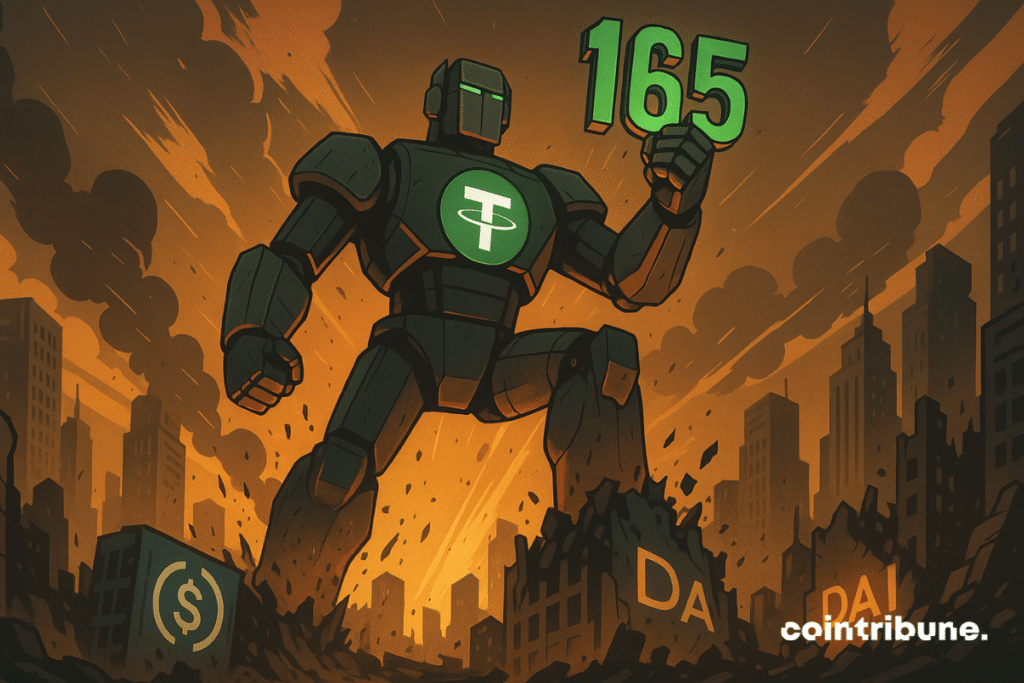Tether reaches 165 billion on a 273 billion market
The stablecoin market has just passed another historic milestone with a total capitalization of 273 billion dollars. Tether consolidates its overwhelming dominance with 165 billion dollars, more than 60% of this booming sector.

In brief
- Tether (USDT) reaches 165.25 billion dollars in capitalization, dominating 60.49% of the stablecoin market.
- The overall stablecoin sector grows by 1.28% over the week to total 273.169 billion dollars.
- USDC consolidates its second position with 66.8 billion dollars, up 7.56% over the month.
- Regulators are scrutinizing more closely this bridge between traditional finance and crypto.
Tether’s stablecoins reach 165 billion
Tether consolidates its position as an unavoidable giant in the stablecoin sector. With 165.25 billion dollars in capitalization, the USDT added 730 million additional tokens in just one week.
This weekly growth of 0.44% and monthly growth of 2.93% reflect an institutional and retail demand that remains strong.
This remarkable performance is explained by Tether’s central role in the crypto ecosystem. Traders use it as a “reserve currency” for their operations, institutions use it for cross-border transfers, and DeFi protocols make it their reference asset. Its exceptional liquidity and presence on all major exchanges reinforce this dominant position.
Circle’s USDC firmly holds the second spot with 66.8 billion dollars. Its growth of 3.56% over seven days and 7.56% over a month shows positive momentum, even if the gap with Tether remains considerable. Circle bets on transparency and regulatory compliance to attract institutions.
But the real surprise comes from Ethena’s USDe, which literally breaks the counters. With a monthly growth of 106%, this synthetic stablecoin now reaches 10.99 billion dollars. This spectacular performance disrupts the established hierarchy and questions traditional stablecoin models backed by reserves.
Increasing competition in a scrutinized sector
The stablecoin landscape is diversifying at lightning speed. Falcon’s USDf shows a monthly growth of 86.35%, while PayPal’s PYUSD grows by 40.26%.
These performances reflect a race for innovation where each player seeks differentiation: yield farming for Ethena, e-commerce integration for PayPal, or real asset tokenization for BlackRock with its BUIDL.
However, not all projects enjoy the same success. BlackRock’s BUIDL, despite being backed by US Treasury bonds, drops 15.61% over a month. This underperformance illustrates the inherent volatility of tokenized financial products, even the most “secure” in appearance.
This rapid expansion draws the attention of global regulators. Stablecoins now represent an unavoidable bridge between traditional finance and the crypto economy.
Their massive use in cross-border payments and their disruptive potential worry central banks, which fear a digital “dollarization” of the global economy.
US and European authorities are increasing consultations on the regulation of these assets. The issue of transparency of reserves, particularly for Tether, remains a major concern. Despite past controversies, USDT maintains its growth, proving that utility often outweighs regulatory considerations in the crypto ecosystem.
With 165 billion dollars, Tether embodies the power and limits of a booming market. Its hegemony remains undeniable, but the rise of challengers announces a strategic battle. Between innovation, institutional adoption and regulatory pressures, stablecoins establish themselves as the new backbone of global digital finance.
Maximize your Cointribune experience with our "Read to Earn" program! For every article you read, earn points and access exclusive rewards. Sign up now and start earning benefits.
Passionné par le Bitcoin, j'aime explorer les méandres de la blockchain et des cryptos et je partage mes découvertes avec la communauté. Mon rêve est de vivre dans un monde où la vie privée et la liberté financière sont garanties pour tous, et je crois fermement que Bitcoin est l'outil qui peut rendre cela possible.
The views, thoughts, and opinions expressed in this article belong solely to the author, and should not be taken as investment advice. Do your own research before taking any investment decisions.